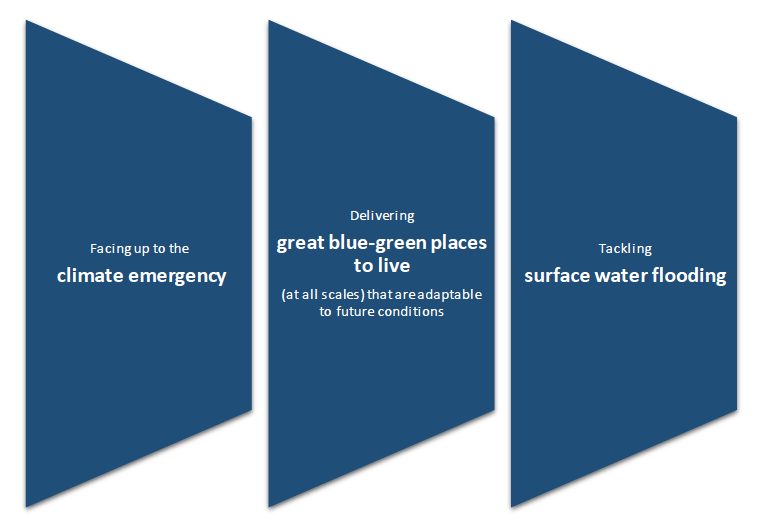Water-resilient places - surface water management and blue-green infrastructure: policy framework
This paper outlines how surface water is currently managed in Scotland, sets out a vision for the future and describes the components that should be brought together to form a coherent framework that will support delivery of water resilient places.
Background
Excellent progress has been made since the introduction of the Flood Risk Management (Scotland) Act 2009 in understanding the impact of flooding in Scotland, where our priorities lie and how we can work together to manage the impacts of floods on our communities.
We are now well into the second flood risk management planning cycle and are learning more about the size of the challenge ahead through better flood mapping, modelling and analysis. Organisations are gaining experience in bringing forward and implementing actions.
As the scale of the challenge becomes more apparent, we are discovering that the rate at which we can reasonably expect to implement actions is likely to be outstripped by the increase in exposure to flooding through climate change.
Our urban areas in particular face mounting challenges with surface water drainage and related flooding. Despite considerable capital investment, the continued densification of our towns and cities is adding to the pressure on drainage systems that are already at capacity and the "total asset" that needs to be flood resilient continues to increase.
To make certain Scotland’s places continue to thrive and remain attractive to people, businesses and investors, we must ensure they are water resilient and set-up for the climate challenges ahead. This will require a concerted effort across all sectors to ensure that new development is appropriately sited and designed and that existing buildings can transition to managing rainwater through blue green infrastructure instead of sewers reducing the pressure on our drainage systems[4].
The three challenges that we must address through a cross-sector effort are:
1. Facing up to the climate emergency – both mitigation and adaptation;
2. Delivering great blue-green places to live (at all scales) that are adaptable to future conditions;
3. Tackling surface water flooding.

Graphic text below
Facing up to the climate emergency
Delivering great blue-green places to live (at all scales) that are adaptable to future conditions
Tackling surface water flooding
The reward for tackling these challenges together will be low-carbon, water-resilient places.
Creating water-resilient places where surface water flooding impacts are minimised will not be achieved by making minor adjustments to current processes. Significant changes to our approach are required.
Success will be achieved by bringing players together behind the common aim of creating great places and by following the Place Principle[5] as adopted by the Scottish Government and COSLA . i.e. "…to help overcome organisational and sectoral boundaries, to encourage better collaboration and community involvement, and improve the impact of combined energy, resources and investment."
By focusing on creating blue-green places that are sustainably drained and have low exposure to flooding impacts we can deliver multiple benefits for our communities, contribute to the National Performance Framework[6] and help deliver Scotland’s ambition for a robust, resilient wellbeing economy post-COVID-19[7].
Attitudes in this topic area are changing with more sectors recognising that blue-green infrastructure can bring multiple benefits and meet a wider range of policy objectives including flood risk management, city regeneration, environmental improvement and enhanced wellbeing and health. Scottish Water’s "no more in; what’s in out." surface water policy stating that they will not normally accept any surface water connections into their combined sewer system also requires a shift in favour of blue-green interventions.
Public sector, private sector, third sector, community and individuals’ activities all have the potential to help ensure that our places are low carbon and resilient to the impacts of climate change. By applying our knowledge of floods and drainage systems to the activities of all sectors we can design a future where increased rainfall, sea level rise and more frequent river flooding demand less of our attention, resources and time. A water resilient society benefits everyone and therefore we all have a role to play in making sure it happens.
Contact
Email: waterindustry@gov.scot
There is a problem
Thanks for your feedback